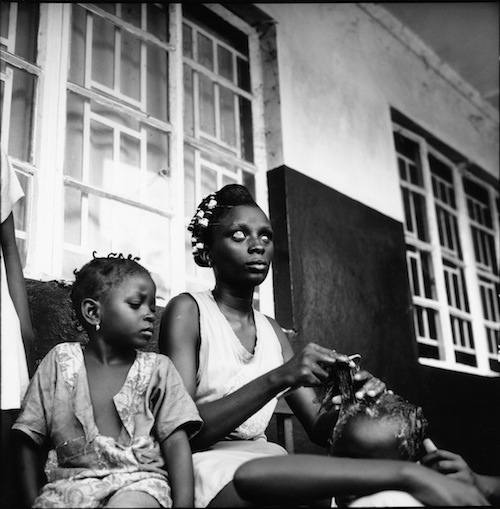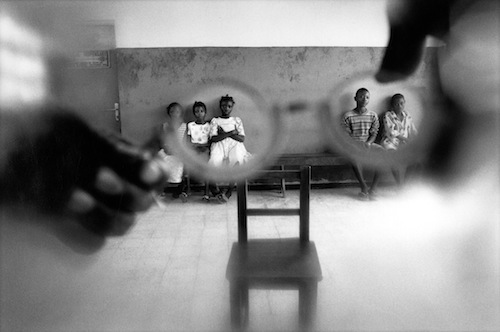
Tim Hetherington, “Untitled,” 1999-2003. Gelatin Silver Print. © Tim Hetherington, Courtesy Yossi Milo Gallery, New York
The subjects of Tim Hetherington’s Inner Light: Portraits of the Blind, photographed between 1999 and 2003 in Sierra Leone’s Milton Margai School for the Blind, were mostly born with the ability to see. At Chelsea’s Yossi Milo Gallery, where the images were recently on view, one was confronted not only with casualties of a civil war but also with the price of their suffering, the images endowing us with sights taken from them.
Whether their eyes have been cut out by rebel groups like the Revolutionary Front or have rotted from a lack of medical care, Hetherington frames the blind in a visual purgatory between extremes: posed or disturbed, drenched in light or enshrouded in darkness. His portraits sizzle like the spooky deserts of Anton Corbijn, but they are embedded with real, omnipresent danger.
In one photo, a child lies arched in the foreground, his face to the sky. In the background a battered piano emerges from the shadows, its keys stuck in playing position, some of them like broken teeth. The passion here is simple and direct, the composition orderly and poignant, the feeling deranged and endless—its underlying chaos born of the distressing push-and-pull between the power of torment and the powerlessness of its tortured subject. One is reminded of a wolf’s chilling howl at the moon.

Tim Hetherington, “Untitled,” 1999-2003. Gelatin Silver Print. © Tim Hetherington, Courtesy Yossi Milo Gallery, New York.
In another peculiar image, a young woman—faced forward with eyes glazed over—combs the hair of a child, perhaps her daughter. Pretty and primped, the woman is a heartbreaking reminder of the persistence of routine in the face of tragedy. It has been argued that blindness leads to the heightened memory of remaining senses, particularly for those who lose their sight at a young age. (Thérèse-Adèle Husson, the French children’s author who went blind as a child, famously dictated the entirety of her landmark nineteenth century autobiography Reflections.) Here, a woman attends to hygienic details as if in a trance, every move memorized and recited. We may be quick to notice and sympathize with her physical ailment, but perhaps we miss the attention and affection with which she grooms the girl. Was there someone to help this woman with her own hairstyle?
Eyeglasses frame the cruelest of Hetherington’s cruel photographs as children glare impatiently through their round lenses. This image both unifies us with, and separates us from, its subjects. “We are going blind,” we are reminded by the photo’s blurred edges. We are looking at those who can only appear to look back at us.

Tim Hetherington, “Untitled,” 1999-2003. Gelatin Silver Print. © Tim Hetherington, Courtesy Yossi Milo Gallery, New York.
This sense of loss and displacement grew only stronger in Hetherington’s work after this series and prior to his untimely death in Libya two years ago. As he became notable for both photojournalism and filmmaking, co-directing the Oscar-nominated Afghanistan War doc Restrepo (2010), and then his own experimental short film Diary (2010), the sadness of his travels seemed to increasingly rattle his convictions.
Hetherington speaks just once in Diary. “I make pictures to try to understand what is happening there for myself,” he says. “If you think by looking at the pictures that there’s no hope, then I’m…” He finishes his film at a loss for words.
Diary, composed of b-footage and reminiscent of the avant-garde shorts of Jonas Mekas, marries scenes of Africa and the West, but only through a bewildering daze of images. Armed youths, nomadic journalists, and wide-open skies spill over into one another. African and American military forces are presented without context; bombs and fireworks, too. We hear screaming coming from behind a closed hotel door—Is Hetherington at home or abroad?
Repeatedly, Hetherington seems to ask himself the question posed to us by Inner Light: What is the function of images that cannot be seen? He considers this question literally and figuratively, perhaps hoping to create a common understanding through his photographs. Surely, Westerners benefit from the experience of Sierra Leone in hindsight. Not only are these photos brimming with haunted beauty but the world within spurs our imaginations. Still, we do not forget that these subjects are, by nature, indifferent to Hetherington’s camera, and that their dark reality is indifferent to our perception.

Tim Hetherington, “Untitled,” 1999-2003. Gelatin Silver Print. © Tim Hetherington, Courtesy Yossi Milo Gallery, New York.
One photo in Inner Light fully considers both Hetherington’s visual medium and subject matter: in it, there is no man, woman, or child. A Margai school bell simply sits atop a table, not handled nor ringing out. Here is a portrait of the blind that forces us not only to imagine the past and present—and all the beauty and savagery they entail—but also our own inability to see beyond ourselves, to alter the past, present, or future with certainty. The bell exists in this moment without anyone to notice it, endowed with a history and life beyond Hetherington’s recognition of it or ours now.
___________________
Tim Hetherington: Inner Light: Portraits of the Blind, Sierra Leone 1999–2003 was on view at Yossi Milo Gallery, April 11-May 18, 2013. The documentary film Which Way Is The Front Line From Here: The Life and Time of Tim Hetherington, directed by Sebastian Junger, is currently streaming via HBO GO.
Joseph Klarl is Art21’s Editorial-Education Intern. He contributes to the Brooklyn Rail and Interview Magazine.



